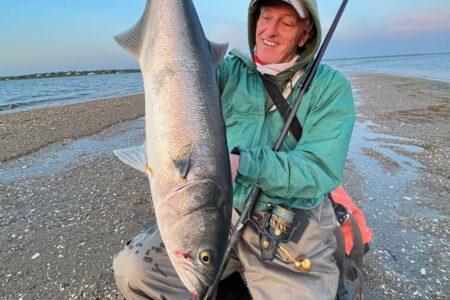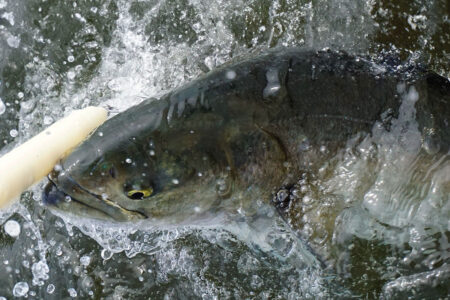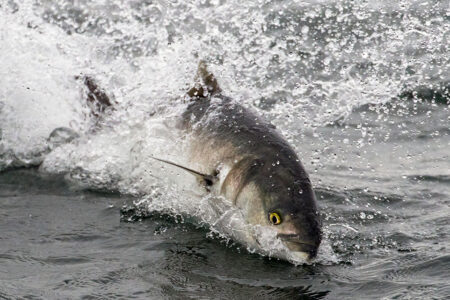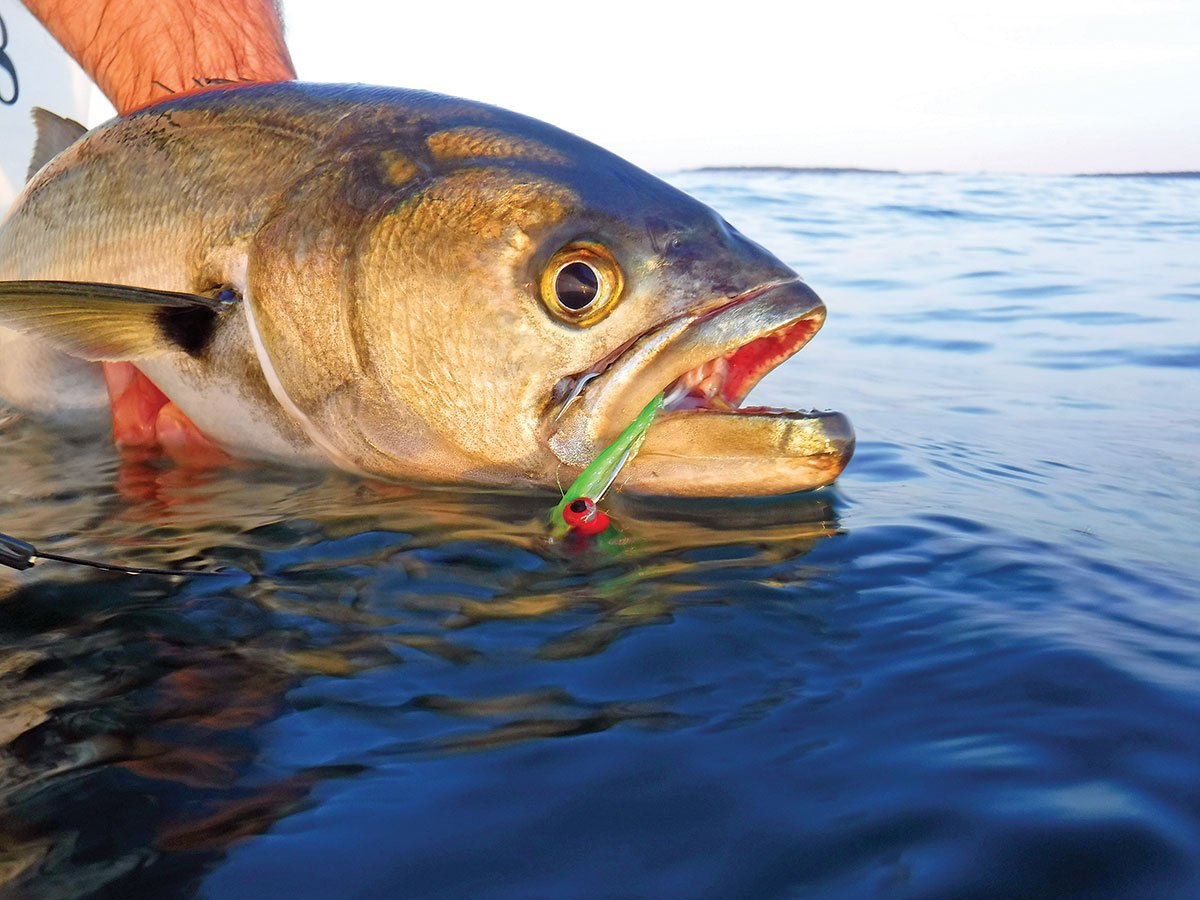
Nuclear fly fishing heats up with bluefish in the fall!
The battle felt like I was tussling with a small Atlantic salmon on the famous Grimsa River in western Iceland. My fly rod was bent in a classic parabolic curve, and the reel whizzed like a bald tire spinning on a snowy hill. The roaring current created whitewater-type rapids and aided the bluefish’s bulldog fight. Suddenly, the 10-knot conveyor-belt of water grabbed our bow and spun the boat around, forcing me to scurry to the stern to avoid a cutoff on the lower unit. Eventually, the bluefish—one of many that day—succumbed to the pressure, and I released it to swim again.
Our “exotic” location was the outflow rip of the Millstone Nuclear Power Plant in Waterford, Connecticut, about three miles southwest of New London. The plant is one-of-a-kind on Long Island Sound and occupies 500 acres. It draws its name from the site’s original and historic quarry, which produced high-quality millstones and building granite. The reactor’s cooling system creates two discharges spewing small rivers of fast, clean, warm water into the Sound, which explains why the fish handled there feel warm—their bodies are 5 to 10 degrees warmer than the surrounding waters.
Ideal for Flycasters
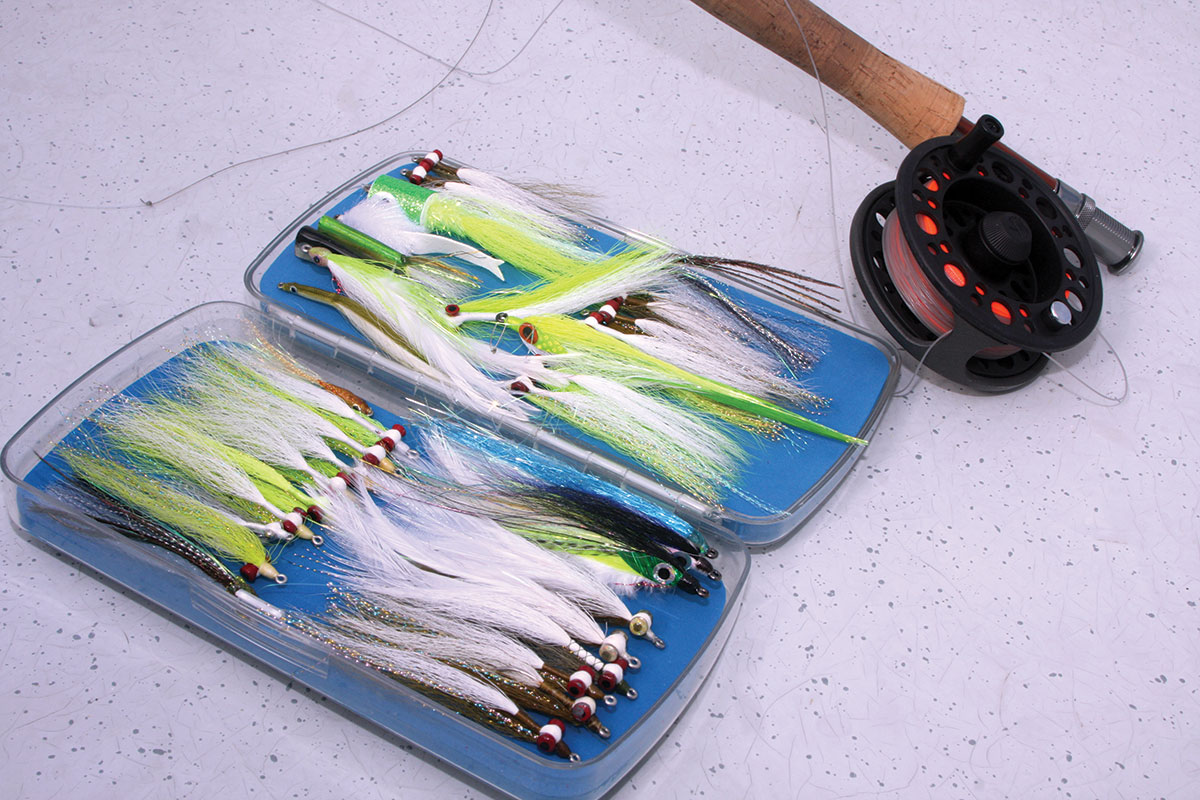
The reason fishing at Millstone is often red hot for small bluefish is the outflows draw and concentrate schools of baitfish like silversides, baby squid, anchovies and peanut bunker, holding them in the nutrient-dense warm water all season. The bountiful bait attracts predators, which arrive in May and stay until cold weather chases them out. These factors create a perfect fly-casting opportunity.
“Millstone is an ideal place for beginning saltwater fly casters,” said guide and fly-fishing expert Sean Callinan, who specializes in coastal fly fishing from stand-up paddleboards ([email protected], IG:@seancallinan), “which is due to the abundance of bait, consistent water conditions and potential for a variety of species to catch. With practice, you can position a boat in the soft water next to the current and therefore don’t need to cast far to reach numerous fish. These are excellent and exciting conditions if you’re a less-experienced fly caster or if you’re introducing someone else to saltwater fly casting.”
Each fall, small bluefish hold in the plant’s warmwater discharges on its east side, making Millstone one of the few nearshore locations where your chances of finding reliably large numbers of blues negates the need to run to a distant rip. Here a small-boat owner can comfortably fly fish within casting distance of shore with a howling 25-knot autumn northwesterly and still be sheltered and within safe distance of two boat launches.
“Anytime I’m hunting for fast action,” said Capt. Dixon Merkt (retired), “I always swing past the plant and check it out. If the boat traffic is light and I see signs of birds or fish, I’ll stop to cast for a while. But usually the bluefish are holding deeper in the current, and you won’t see any signs on top so it’s still important to try. The fish can be feeding anywhere from right in the mouth of the discharges to tailwaters where the current dissipates into the bay water, which is about one-quarter of the way towards Two Tree Island.”
During the years immediately following tragic 9/11, homeland security regulations prohibited fishing near the plant—from shore or boat. Since then, the restrictions have loosened, and boat anglers are again permitted access to these prized waters, but only on the outflow (eastern) side. Shore fishing is permanently banned, which benefits boat anglers because there are fewer lines in the water to cross and tangle.
How to Fish the Outflows
Determine your approach to fishing the outflows by the presence and location of other boats. If you have the rip to yourself it’s best to first idle in close to the mouth of the discharge, keeping an eye on your depthfinder as you approach. Begin casting there, but after investing 15 minutes and you have no hits gradually start covering water farther downstream.
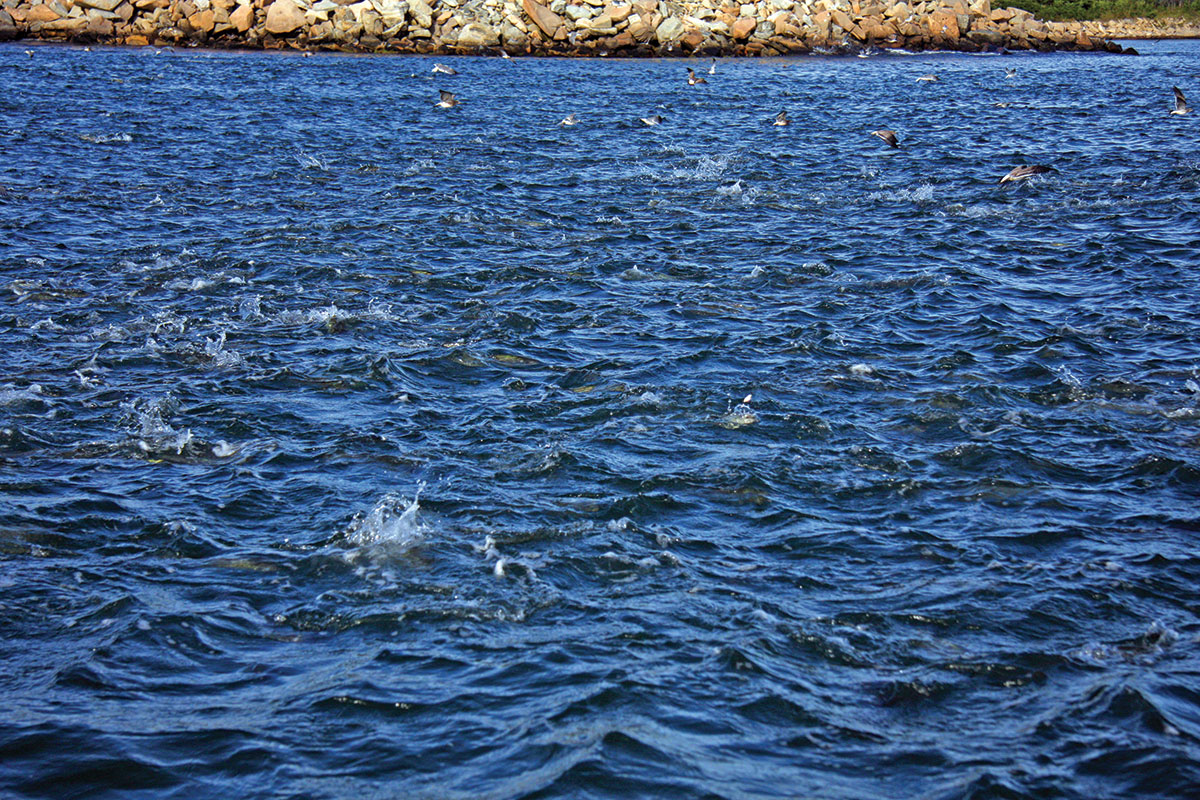
“First, observe the conditions before maneuvering your boat into position,” advised Callinan, “such as birds diving and bait or predators breaking the surface. Be aware of other boats fishing, where they are casting and what direction they are drifting. Sometimes boats anchor nearby, but they’re usually bottom fishing. Assess wind direction for optimum casting as well.
“Start fishing 20 feet from the shore by sliding your boat into the still water next to the outflow. Treat the warmwater discharge as a trout or salmon river, casting across the discharge area or diagonally down-current to the opposite edge of the moving water, if you can reach it.
“Allow your fly to swing downstream in the current and retrieve with short strips to give the fly action. This will imitate a struggling or injured baitfish. Avoid using high-speed, long-strip retrieves because that appears unnatural due to the speed of the opposing current. Try mixing up your retrieve to ensure you’re fishing as many layers in the water column as you can. Keep your rod tip only an inch or two off the water and watch your line to ensure the straightest path between rod tip and the fly. In other words, avoid wildly-fast swings of the fly caused by the current pushing a deep curve in the midpoint of your line.”
Avoid anchoring or motoring directly in the discharge waters because the current is strong enough to swamp a small boat. The waves are especially big when a brisk east wind opposes the outflow.
Fly Tackle
Fly gear doesn’t need to be fancy or expensive for Millstone, which makes it a great fishery for novices and pros alike, but tackle does need sufficient backbone to handle battling a fish in the strong current, which can double the normal pressure on light gear.
“I recommend a 9-foot, 8- or 9-weight rod,” said Callinan, “matched to a large-arbor reel filled with an 8- to 9-weight intermediate or 200- to 300-grain sinking line. This could also handle a false albacore if one grabs your fly. For leader material, I suggest a 7- to 9-foot length of 20-pound monofilament or fluorocarbon. Remember to tie on a short bite tippet of 50-pound mono/fluoro or thin wire to avoid cutoffs from these toothy critters. Bluefish will readily attack any minnow pattern, which include chartreuse-over-white Clousers, Deceivers, menhaden, sand eel and surf candy patterns. In case the fishing is hot, come prepared with plenty of extras.”
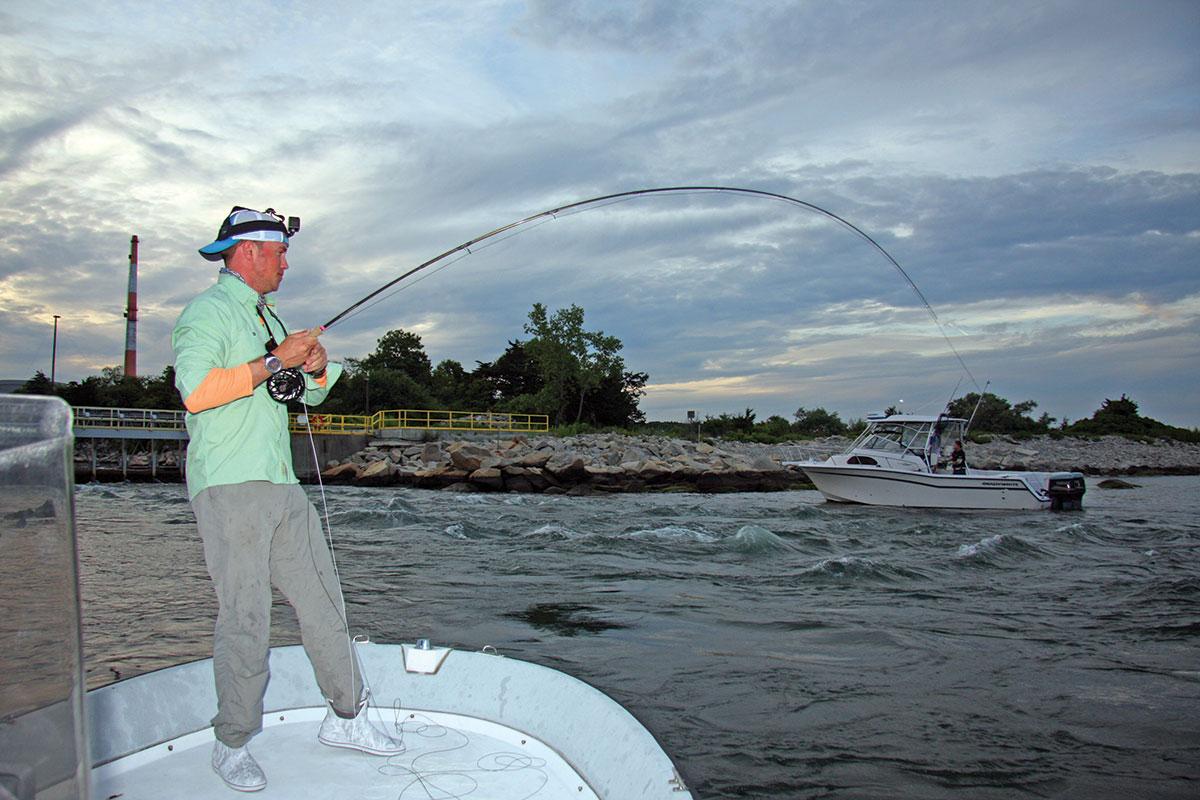
Fishing the Intake Side
Methodically work the entire length of each discharge until you find predators. Fish will feed anywhere from the whitewater emanating from the steel bulkheads to the tail end of the slowest water 100 yards or more from the shore. However, the intake (western) side of Millstone often holds pods of surface-feeding harbor bluefish or schoolie bass. This summer, dense schools of small stripers slurped tiny baitfish on top for many weeks, and that action will likely continue through the fall.
Security is much tighter on the intake side than on the outflow side of the plant due to greater vulnerabilities of an intake. This can be frustrating at times because you can only fish with your vessel outside the warning buoys (exclusion area non-lateral markers). The key and legal method is to cast from outside this perimeter, sometimes waiting for the schools to move away from the shoreline riprap and out into casting range. The fly-fishing action can be intense on either side of Millstone so be ready for some red-hot autumn sport.

